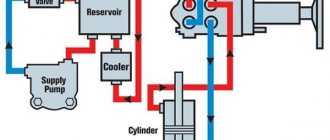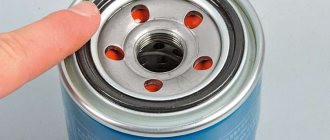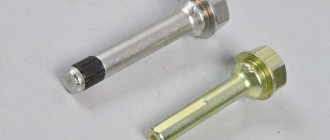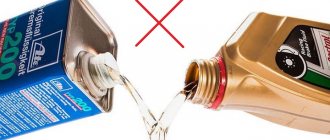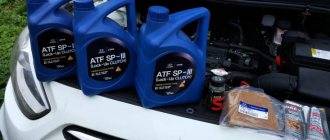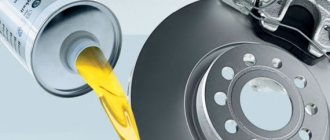For the safe operation of a Hyundai Solaris, the condition of the brake fluid is important. It should be changed promptly, following the manufacturer's recommendations for selection.
Carrying out the replacement will not be difficult with your own hands, but the car owner should still know some of the intricacies of the event.
The original Hyundai Brake Fluid is poured into the brake circuit of the Hyundai Solaris. It is sold under article number 0110000110. The volume of the canister is one liter, and the price ranges from 380 to 550 rubles. Branded brake fluid is classified as DOT-4.
Original brake fluid for Hyundai Solaris
It is allowed to fill the Hyundai Solaris brake system with fluid from third-party brands. As an alternative to the original, you can choose any technical specification that relates to DOT-4. The table below presents the best options from third-party companies that have gained wide popularity on the Hyundai Solaris.
Table - Good brake fluids for Hyundai Solaris
| Brand | vendor code | Estimated cost, ruble |
| VAG | B000750M2 | 290-390 |
| Polkar | VA402402 | 260-290 |
| Honda | 0820399938 | 550-590 |
| TRW | PFB450 | 120-260 |
| General Motors | 93160363 | 425-610 |
| Bosch | 1987479106 | 150-245 |
| ATE | 03990158012 | 155-175 |
| Brembo | L04005 | 145-165 |
| Peugeot/Citroen | 469934 | 500-550 |
What kind of liquid should I fill? Original and analogues
The manual specifies two types: DOT-3 and DOT-4.
For some reason, the more modern DOT-5.1, which is also suitable, is missing. What's the difference between them?
Probably the most important thing is the boiling point. Typically the operating range of the fluid is 80-130 degrees. Depends on ambient temperature, driving style and operating conditions.
The more water the liquid has absorbed, the lower the boiling point. For example, during a long descent or after a series of aggressive braking, the pedal may suddenly begin to fall, making braking ineffective. It’s good if the driver manages to make a series of pedal strokes, but time will be lost in any case.
The higher the type, the greater the reserve.
Boiling temperature. New and old fluid
There is a difference in the feel of the pedal. Especially noticeable in winter. The tightest pedal on the four. At 5.1, power is transmitted faster and more accurately. In the summer, when operating temperature is reached, there is practically no difference.
It is believed that 5.1 has improved anti-corrosion properties. This is difficult to determine within the framework of SRT. Another thing has been noticed: whoever does not change the fluid will encounter corrosion inside the brake system over long runs; even the most modern fluid will not help here.
Below are the original and well-known brands used in our work. Articles are provided. They can be used when purchasing in online stores. For details, see the section Purchasing liquids through online stores.
Be careful! Containers vary in volume! Canisters 0.5 and 1 liter.
Original DOT-3 Hyundai fluid.
Article: 0110000100, 1l canister
Original DOT-4 Hyundai fluid.
Article: 0110000110, 1l canister
Usually the most affordable are Sintec and Lukoil. Tested on cars used in taxis. No problem, you can use it.
Article: 800735, 1l canister
Article: 1338295, 1l canister
Among imported ones, TRW and Mobil are among the most affordable.
Article: 1338295, 0.5l canister
Article: 150906, 0.5l canister
DOT 5.1, TRW and Brembo.
Article: 150906, 0.5l canister
Article: L05010, 1l canister
What's already in the car?
The Korean auto giant releases its models from the assembly line, filling them with DOT-4 class fuel oil. Its manufacturer is not determined, it is marked as Hyundai/Kia 01100-00110 BRAKE FLUID.
It is not always possible to purchase a similar one for replacement, but here the car enthusiast has the opportunity to choose any brand if it meets the criteria applicable to the DOT-4 standard, regardless of the specific manufacturer.
You need to purchase the volume of liquid that will replenish the entire amount in the vehicle. This is approximately 1.25 liters. But if we take into account the volume that is located in the clutch drive, the total result is 1.75 liters.
Liquid volume and level
The volume for automatic and manual cars is slightly different.
0.7l automatic transmission, 0.8 manual transmission
Why is that? Pay attention to the tank. On a manual car, it is common for brakes and clutch. Hence the additional 0.1 l.
Hose for clutch circuit
The car has an automatic transmission, here the fitting is sealed from the factory.
Reservoir for a car with automatic transmission
Liquid level. The manual recommends checking every 15,000 km.
During operation, the level decreases. The reason is wear of the brake pads. Some people in this situation begin to add fluid to the MAX mark. Do not do this! When replacing the pads, the excess will be squeezed out through the cover into the engine compartment.
You just need to check that it does not go below the MIN mark. Only in this case we top up and immediately contact the service. Most likely there is a leak, or all the pads are critically worn.
Minimum permissible liquid level
Conclusion
On the one hand, replacing brake fluid in a Hyundai Solaris is simple, especially for those who have already carried out such a process. For a beginner, this procedure may seem quite difficult to understand, and even more so to perform, so in this case it is recommended to contact a car service.
The car requires the attention of the owner, if you are an owner who does not particularly care for his car, then you still have to do it. Of course, not all parts need to be changed and all that, but the filling fluids in cars definitely need to be changed! If you don't believe us, then ask a good auto mechanic. And so closer to the point, the Hyundai Solaris car is no different (in particular) from other cars. And so on this page we will look at how much and what kind of liquid you need to pour into your car.
When to change? Replacement dates and intervals
It is generally accepted that brake fluid needs to be changed every two years. Even if the car has not been used. In practice, the decision is made based on the concentration of water in the liquid. The actual operating range is usually 2-3 years. Depends on the climate zone, operation and manufacturer.
Dead liquid can be determined by a simple visual inspection: there is turbidity and dirt in the tank - change it!
For visual cleanliness, use a tester. There are two points here. First: everyone uses the cheapest ones, which are able to determine the presence of water, but not the exact percentage of content!
The cheapest tester
If you bought one, you will have to check the accuracy of the measurements experimentally. Just like in the video.
Below is a semi-professional tester that can determine the concentration. Before measuring, the type of liquid is selected, and only after that the test is carried out.
The second point: when taking measurements, the electrodes must be completely immersed. Not partially!
Incorrect measurement
Correct measurement
When contacting the service, there is a 99% chance that the test will be carried out by a cheap tester. Therefore, you need to: firstly, monitor the correctness of the measurement and secondly, as I wrote above, take into account that the percentage scale on the device can show the weather. Therefore, it is better to use the following approach: one or two yellow diodes light up - replace the fluid.
If the device shows incorrectly, the data is distorted downward. Therefore, when we see 1-2%, most likely the real content is higher than 3%. Green light, no water.
Required Tools
To replace the TJ with a Hyundai Solaris, you need the tools from the table below.
Table - List of tools required to change brake fluid
| Tools | Note |
| Box or open-end wrench | "on 10" |
| Tara | Volume about 2 liters |
| Hose | Transparent |
| Jack | To lift the car |
| Balloon wrench | For wheel removal and installation |
| Rags | To clean dirt |
